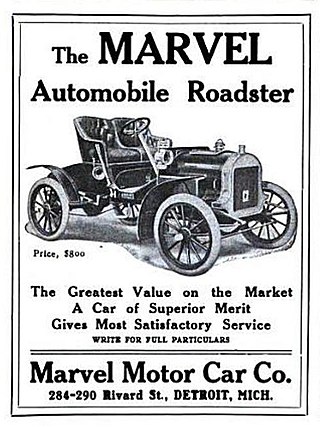
Maxwell was an American automobile manufacturer which ran from 1904 to 1925. The present-day successor to the Maxwell company was Chrysler, now Stellantis North America, which acquired the company in 1925.

The Ford Model N is an automobile produced by Ford Motor Company; it was introduced in 1906 as a successor to the Models A and C as the company's inexpensive, entry-level line. It was built at the Ford Piquette Avenue Plant.

Grout Brothers was a manufacturer of steam-powered automobiles in Orange, Massachusetts. The three brothers, Carl, Fred and C.B. were set up in business by their father William L., who had made sewing machines under the New Home name in partnership with Thomas H. White. The early cars were sold under the New Home name.
The National Motor Vehicle Company was an American manufacturer of automobiles in Indianapolis, Indiana, between 1900 and 1924. One of its presidents, Arthur C. Newby, was also one of the investors who created the Indianapolis Motor Speedway.

A high wheeler is a car which uses large diameter wheels that are similar to those used by horse-drawn vehicles. These cars were produced until about 1915, predominantly in the United States.

The Gas-au-lec was an American automobile manufactured by Corwin Manufacturing Company of Peabody, Massachusetts.
The King-Remick was a brass era automobile built in Detroit, Michigan, in 1910.

The Marvel was an automobile built at 284–290 Rivard Street, Detroit, Michigan, United States, by the Marvel Motor Car Company in 1907.
The Austin was a brass era American automobile manufactured in Grand Rapids, Michigan from 1901 to 1921. The company, founded by James E. Austin and his son Walter Austin, built large, expensive and powerful touring cars with an unusual double cantilever rear spring arrangement placing the rear wheels behind the passenger compartment, for a longer wheelbase to improve rider comfort in an era of rough roads as well as a unique two-speed rear axle.

Lincoln Motor Car Works was an automobile company in Chicago, Illinois. It produced cars for Sears Roebuck from 1908 until 1912.
The Success Automobile Manufacturing Company was a brass era United States automobile manufacturer, located at 532 De Ballviere Avenue, St. Louis, Missouri, in 1906.
The Colt Runabout was an American Brass-era automobile built in Yonkers, New York, in 1907 by William Mason Turner.

The Keeton was a brass era automobile built in Detroit, Michigan from 1912 to 1914 by the Keeton Motor Car Company.
The American Automobile and Power Company was an American Brass Era car manufacturer, incorporated in Sanford, Maine, in 1903. They produced the American Populaire during 1904 and 1905.

Hatfield Motor Vehicle Company was a pioneer brass era American automobile company, built in Miamisburg, Ohio, in 1907 and 1908.
Kauffman Motor Vehicle Company was a pioneer brass era, American automobile company, built in Miamisburg, Ohio, from 1909 until 1912.

The Porter Motor Company was an early American steam automobile manufacturer based in Allston, Massachusetts.

The Waltham Steam was an American steam car.

The Buick 4 was a series of passenger cars produced by the Buick Division of GM from 1909 through 1918, and was available as a touring car, phaeton or roadster. It was available with the Buick Model B as a larger alternative offering a larger engine and better durability. It became the junior sedan in 1914 when the Buick Six was introduced.












